This post originally ran in September of 2014 and I’ve not been back to this wild desert party since.
I’ve just returned from Burning Man, a Mad Max bacchanalia in the desert of western Nevada. I went to see what my civilization was up to, what fiery pinnacle we’ve invented. I also wanted to see it in context, which is why my time at this 69,000-person conflagration was only part of a larger journey.
I began with a crew of six in a barren rock mountain range north of Burning Man, and we spent six days with backpacks traveling south toward a rising glow on the horizon where at night you’d normally see only darkness. Our route took us along the shorelines of ancient Lake Lahontan, which peaked around 11,000 years ago as glaciers melted into the end of the Ice Age, leaving most of northwest Nevada underwater.
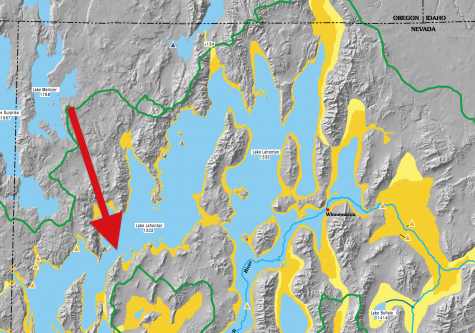
I took this route to put the spectacle of Burning Man into perspective. Though this desert now appears empty, inhospitable and perhaps rarely visited by people, it has a different sort of history. During the cold, arid Younger Dryas climate-anomaly that struck the Northern Hemisphere around 12,000 years ago, the Great Basin became a well-watered oddity. It was one of the best places to live on the continent, and people left countless stone tool remains along ancient lake shores that now stand barren and windswept. As we walked ridges above what had been one of the largest freshwater bodies on the continent, we found work stations where people had sat flaking butterscotch-colored rock. Among hundreds upon hundreds of sharp slivered stones were actual worked pieces, elegant preforms ready for transport, where they would have been later made into spear points or scrapers.
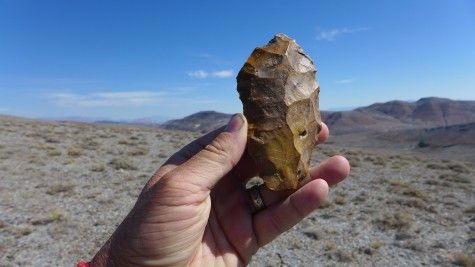 Seeing this much human activity stood in stark contrast to the desolation around us. We’d seen some lizards and spiny little shadscale bushes, and not much else. Nothing here now but these stones spoke to what was here before, a completely different landscape of animals.
Seeing this much human activity stood in stark contrast to the desolation around us. We’d seen some lizards and spiny little shadscale bushes, and not much else. Nothing here now but these stones spoke to what was here before, a completely different landscape of animals.
During the summers of 1981 and 1982, the complete skeleton of one of largest mammoths found on this hemisphere was excavated from the foot of one of these mountains. Thirteen feet tall at the shoulder, it was found beneath blowing dunes a short distance onto the playa, probably where it fell on a beach that no longer exists. Three ribs show healed fractures of an older animal, big mammoth bull at the edge of the lake.
A single milk tooth of a young saber-tooth cat turned up in the excavation, offering a sketch of what might have happened there. Not only were adult cats on the carcasses, but the young were coming in for a blood-muzzled meal. The excavation also revealed 32 stone tools nested around the mammoth bones, giving greater definition to this animal’s demise. Whether the people were scavengers or the very spear-bearers who took this beast down is hard to tell. If scavengers, they may have had to run off the saber-tooths, hooting and hollering and charging with spears while the big cats snarled and swept their ten-pound paws in the air before reluctantly loping away. Or it didn’t happen so easily, the balance still tenuous between hunter and hunted as one aggravated cat charged the figures, taking advantage of a gap, a moment of hesitation, and its body would have struck like an African lion: claws first, then the grip of forearms, and a quarter second later the lash of teeth and flaring neck muscles, spear shaft shattering as the life of a skin-clad man or woman ended.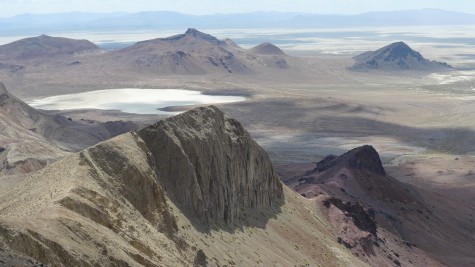
The mammoth may have fallen on a beach and was soon covered by pulses of glacier melt as the lake rose, preserving its bones deep in anaerobic, waterlogged muck now turned to dust.
How would you know these stories were ever here? Excavations and painstaking surveys have drawn legends out of the ground. Attendants at Burning Man exclaim that they have come to an empty place, a void on which to witness one of the biggest parties on earth, but how much richer the story becomes when you know what is in the ground beneath you.
Each night, the light of Burning Man glowed brighter as spotlights began sweeping the sky. Seven miles north of the site we watched volleys of flame shoot out of the spread of colored lights. Even this far away, lasers struck our bodies. I knew what it would be like in there, almost impossible to be aware of what is any farther around you than the noise and blazing light.
On the final morning of our walk, under the lone shade of our umbrellas we strode toward a wall of sound, an arrhythmic, thumping soundtrack of sunrise DJs. We entered from the silent desert and its retired histories to the riveting buzz of here and now. You no longer had to stretch your senses to the point of imagination. By that afternoon, we were in the thick of nakedness and fur-lined costumery. Winds and playa dust howled around enormous art installations. No hour of day or night was any quieter, as primal, competing drumbeats drilled your skull to the point of ecstatic madness. Five nights later, the great wooden man at the center of the site burned to the roar of tens of thousands of celebrants. Fireworks and plumes of flame swelled into the sky as I imagined us at the bottom of a lake, all of us hundreds of feet underwater.
First image, James Q Martin; the rest, Craig Childs
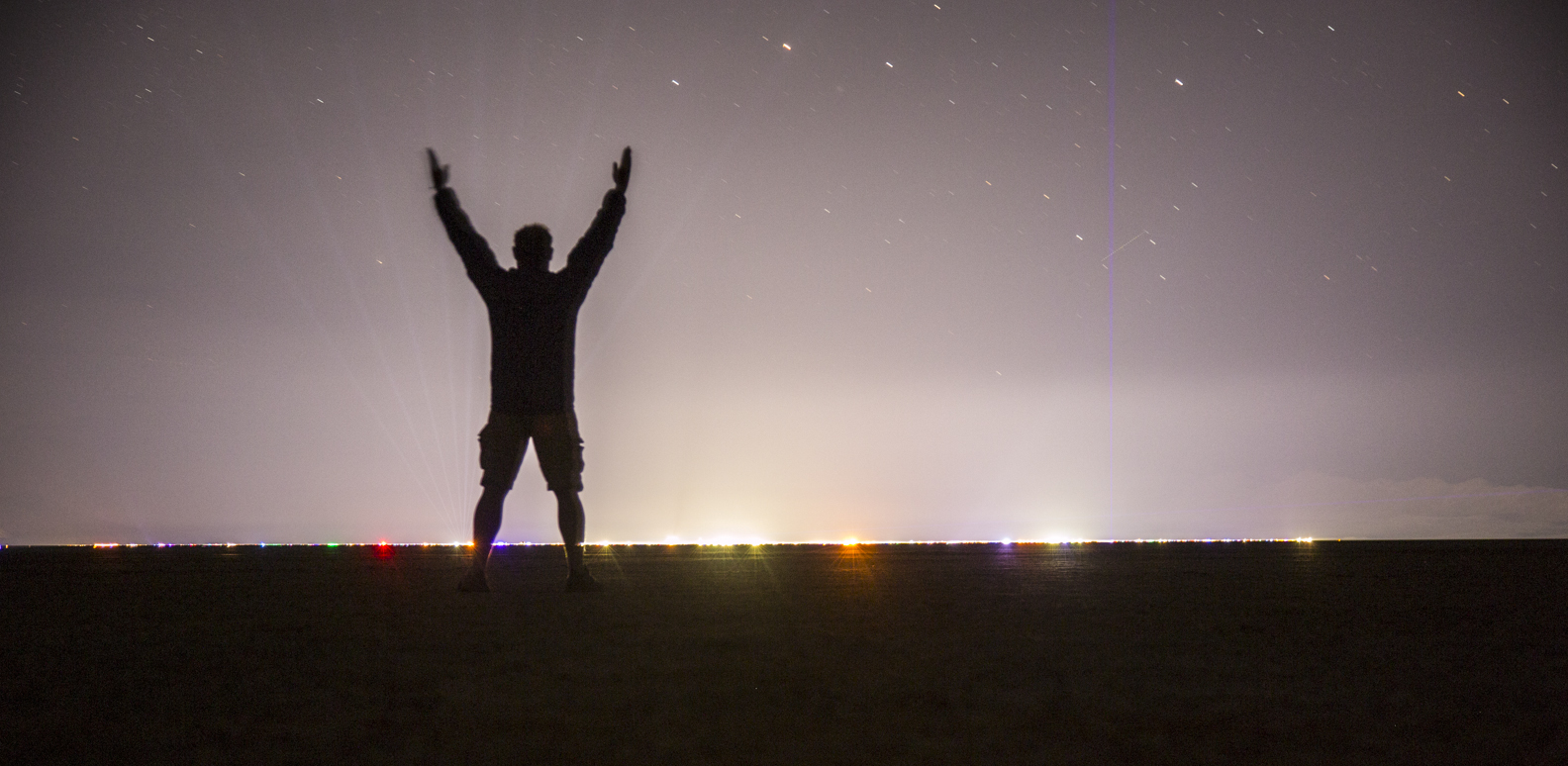
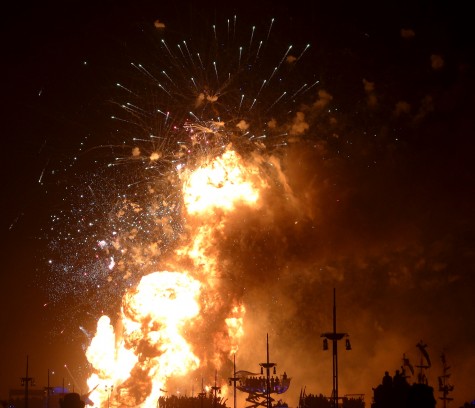
Excellent! Thank you!
A very enjoyable read that puts a whole new perspective on the festival.
I’m sure glad we have Craig Childs. A wonderful talent who has an eloquent knack of combining my favorite things: adventure, art and science.
We quite like him too.
I love the history about the land. Another good read is Hands on the Land. A book about Vermont
I, for one, can’t stand the guy. Just kidding. Thanks, Craig. Sounds like a great way to get to one helluva party.
Did the constant noise bother you?
I love the way you write. I like the picture of the chipped rock. It is amazing that you are holding something that someone so very long ago took the time to chip and shape into a tool. You are holding a piece of history. Very interesting story.
I agree with Connie, holding a piece of ancient history is so cool. You can still buy pieces of the Berlin Wall when you are in Berlin. It’s awesome to be able to hold pieces of history, thanks for posting the awesome picture.
Thanks for the appreciations. The constant noise? Yes, it was crazy-making. No hour of day or night was quiet, but it did have a certain appeal in the short burst of that event.
One word. Earplugs. Without them Burning man wouldn’t work for me.
Ah, the dream of parties long past. The lives spent long ago. All that dust and heat and sound.
These days, in the quiet of a pretty room, I listen to a lot of music by Yann Tiersen. Here is what he has to say about existing in the moment with music (courtesy of the pale blue post-it note stuck to my wall): “Let’s live in an enormous world of sound we can use randomly, with no rules at all. Let’s play with sound, forget all knowledge and instrumental skills, and just use instinct–the same way punk did.”
And so you may know Yann Tiersen, too, here he is playing a piano set down on grass near still water. (https://www.youtube.com/watch?v=KwwwWz6Ef3I)